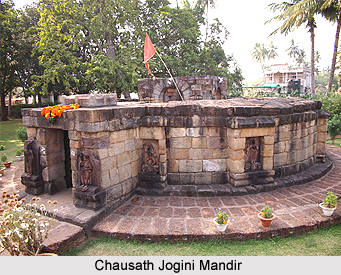 Chausath Jogini Mandir, also known as 64 Joginis Temple, is located in a village Hirapur at a distance of almost is situated in a hamlet called Hirapur, 20 kms outside Bhubaneshwar in the Indian state of Orissa. The presiding deity of the temple is Goddess Kali. The historical record of this ancient shrine states that the temple was built in the 9th century by Queen Hiradevi of Bramha Dynasty.
Chausath Jogini Mandir, also known as 64 Joginis Temple, is located in a village Hirapur at a distance of almost is situated in a hamlet called Hirapur, 20 kms outside Bhubaneshwar in the Indian state of Orissa. The presiding deity of the temple is Goddess Kali. The historical record of this ancient shrine states that the temple was built in the 9th century by Queen Hiradevi of Bramha Dynasty.
Legend of Chausath Jogini Mandir
According to a legend the Goddess Durga once took the form of 64 demi-goddesses to annihilate a demon. After the battle the 64 goddesses or Joginis requested Durga to install in a temple structure.
Architecture of Chausath Jogini Mandir
Chausath Jogini Mandir, located far away from the cacophony of city life, breathes the subtle nuances and the restrained emotions of the rustic life of the villagers. The temple, circular in plan, has been fabricated with blocks of sand stone. The interior portion of the circular wall marked by a hollow space is substituted by idols of Goddess. The bedecked walls defined by recesses and niches are engraved with 56 striking idols, carved out of black granite. These magnanimous figurines, arresting the attention of the onlookers with its charm and allure, centres around the chief deity of the temple; Goddess Kali standing erect on the prostrating image of Lord Shiva. The temple also has a central altar housing the images of eight goddesses on its four sides.
Deemed to be a trantric shrine, 64 Joginis Temple has been kept completely open on the top. The Jogini idols usually represent a female figurine standing on an animal or a demon or on a human head. They symbolise the victory of Shakti.
This article is a stub. You can enrich by adding more information to it. Send your Write Up to content@indianetzone.com





















